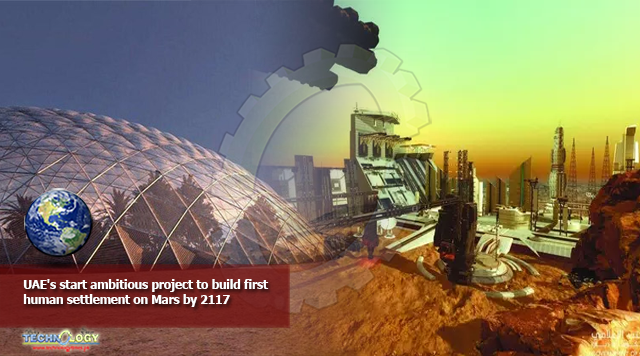A new research finding on radiation will support the UAE’s ambitious project to build the first human settlement on Mars by 2117, a scientist told Emirates News Agency, WAM.

UAE’s Start Ambitious Project To Build First Human Settlement On Mars By 2117 : “Radiation is one of the biggest roadblocks in planning long-term space missions, especially the project to establish a human presence on Mars [UAE’s Mars 2117 project],” said Dr. Dimitra Atri, Research Scientist at Centre for Space Science in the New York University Abu Dhabi, NYUAD, who has made important findings from his research on the impact of radiation on astronaut health in long-term space missions.
His team has been able to calculate the amount of radiation dose deposited in different organs of the human body from astrophysical sources very precisely.
Radiation on astronaut health
“We found that radiation exposure to astronauts is comparable to the dose that cancer patients receive during radiation treatment,” he revealed in an interview on Monday.
“By comparing our calculations with radiation therapy data we have been able to estimate health risks to astronauts from background radiation in space [Galactic Cosmic Rays] and solar storms [Solar Proton Events],” Atri said.
“Equipped with this knowledge, we will be in a better position to develop technologies to mitigate the impact of radiation and help with UAE’s efforts to establish a human base on Mars. We will be publishing our findings very shortly and share our results with the scientific community in the UAE and abroad,” he explained.
First city on Mars
As announced in 2017, the UAE’s Mars 2117 project includes putting in place a programme to prepare Emiratis for Mars and space exploration. The project aims to build the first city on Mars in 100 years, which will be achieved through various scientific alliances.
The project will be associated with research themes involved in the exploration of faster transportation systems to Mars, as well as building houses and producing energy and food. It will also try to find faster transportation methods for travelling to and from Mars.
As WAM reported on 12th July, 2020, a senior scientist at the National Aeronautics and Space Administration, NASA, said that the UAE’s plan to build the first human settlement on Mars by 2117 would be possible.
“I think we’ll get there,” said Dr Lori Glaze, planetary science division director at NASA, adding that “I would say that having multiple countries now [on Mars exploration] has increased our capability [globally] of going back and forth to Mars.”
Space biology laboratory to support ISS mission
Dr. Atri, the research scientist, continued to say that a planned space biology laboratory at the Centre for Space Science at NYUAD will support the UAE’s research aboard the International Space Station, ISS.
“The laboratory will have two components: a microgravity component, which will simulate microgravity for microbial samples, and a radiation component where we will expose microbial samples to UV radiation. The idea is to be able to simulate outer space-like conditions in the laboratory,” explained Atri, an astrophysicist interested in Mars, exoplanets, human spaceflight and astrobiology.
The UAE has a growing human spaceflight programme and its next step is to carry out scientific experiments on board the International Space Station, he pointed out.
“Our research in the laboratory will help us develop potential experiments to be carried out aboard the ISS and help with UAE’s efforts in this field. We are currently assembling and testing our microgravity equipment and should be able to start conducting experiments later this year,” Atri revealed.
Using Hope Probe data
The NYUAD Centre will be using data from Hope Probe, the UAE’s historic mission to Mars, for these researches, he said.
“One of our aims with the Hope probe data is to understand how background galactic cosmic radiation and radiation from abrupt solar storms interact with the Martian atmosphere,” the scientist said.
“We will combine data from Hope Probe with NASA’s Curiosity rover data, which is based at the Gale crater on Mars to understand how radiation propagates all the way down to the surface of the planet. This will help us better understand the radiation environment on the surface of Mars in case of extreme events which will be very useful in planning human missions on Mars,” Atri explained.
“We are also interested in learning more about how solar radiation contributes to the erosion of the Martian atmosphere and how it changes its chemical composition on short timescales,” he added.
Research on life on Mars
About his research on life on Mars, Dr. Atri said the surface of Mars has been studied extensively over the years, but the subsurface environment is unexplored.
In a paper published in Nature science journal in July, he has proposed a mechanism using which life, if it ever existed on Mars, could survive just below its surface at present.
The ExoMars mission, a joint endeavour between Russia’s Roscosmos State Corporation and the European Space Agency to be launched in 2022, will study samples from up to two metres below the surface and these will be the first ever results from the subsurface environment, including studies of signs of life, he said.
“There is a potential for a breakthrough as soon as a mission starts collecting subsurface samples after landing. As ExoMars has a launch window between August and October 2022, I am hoping we will get results sometime by summer 2023,” the scientist said.
Originally published at Emirates news agency